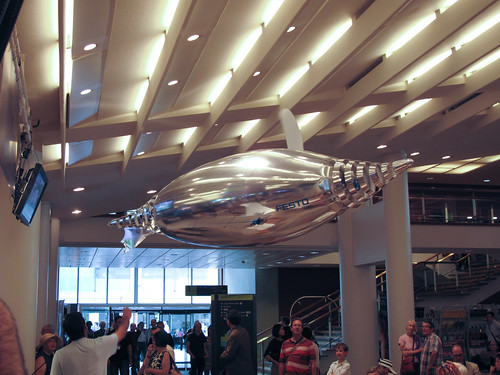
2010 is the 350th anniversary of the Royal Society. We’ve had a special series of In Our Time earlier in the year, the president of the Society, Martin Rees has given the Reith Lectures, and there’ve been numerous talks and lectures.
Over the weekend, the Royal Society’s annual summer exhibition moved to the Southbank Centre where it has became the See Further Festival. All around the South Bank and Royal Festival Hall, were exhibits of what British scientists are currently doing. Various research labs and companies were present with live demonstrations explaining the practical applications of what they’re doing.
Amongst many things I saw over the weekend were a new holographic method being developed for finding landmines, what we can learn from how insects navigate, and the development of an incredible new magnifying lens. And they’re just a handful of the exhibits. On Friday, I saw Material World’s Quentein Cooper interviewing someone about volcanoes, and reporters from a variety of international media talking to the scientists involved. Elsewhere, a little girl was being CT scanned by a large pink Siemens magnetom. And Festo had an Air Penguin that was very gracefully flying through the enclosed Royal Festival Hall’s atrium and was as elegant a flying machine that I’ve ever seen.

Outside the BBC’s Bang Goes The Theory roadshow seemed popular, with Dr Yan in attendence.
The exhibition is open to next weekend, and if you’re near London, is well worth a visit.
The reason that I reached the exhibition so early is that on Friday the “Premiere” of 2001: A Space Odyssey with live orchestral accompaniament was taking place. I first saw this film in one of its re-releases (they still used to do things like that in the late seventies) with my dad and brother at the Barnet Odeon. It is one of the few times I’d experienced an intermission in a film. Indeed, so unusual was such a thing, that I remember wondering whether the projectionist hadn’t just introduced it on the cinema manager’s orders so that he could sell more Kia Ora and popcorn. But it left an indelible memory – not least as 9 year old tried to understand “Jupiter and Beyond the Infinite”.
To my young mind, it opened with a tediously long sequence involving apes – “The Dawn of Man”. But I remember watching and being mesmerised nonetheless. The moment that one of the apes throws a bone skywards and it becomes a spaceship heading towards an orbiting space station, accompanied by the Blue Danube, is one of cinema’s most glorious moments. The piece is roughly 11 minutes long, and Douglas Trumball’s effects, still stand up perfectly fine today. I guess that working with Arthur C Clarke for verisimilitude, Kubrick’s ceaseless quest for excellence meant that he did as good a job in 1968 as anyone could do today.
For this production, Warner Bros had gone back to the film’s audio master and separated the music cues from the dialogue and sound effects so that the Philharmonia Orchestra and Philharmonia Voices could be added in live. While music is vital to 2001, it’s actually used relatively sparingly; think of those scenes where all you can hear is Keir Dullea’s breathing within his spacesuit. Conductor André de Ridder had a timecode alongside him to ensure that the cues were all met in timely manner.
Kubrick’s widow, Christiane, introduced the evening’s event, and noted that Stanley would have been shocked for his wife to have been speaking in public (when she sat down near me, and I realised that I was surrounded by friends and family, I must admit to being quite thrilled). Famously reclusive, it seems uncertain whether he would have attended at all. He might not have been completely taken with the projection. While the picture – I suspect an HD version – was pin-sharp, and perfect technically, he might have been a little annoyed that the orchestra needed any light to work beneath the screen.
Yet, all said and done, it was a wonderful experience, and was given a standing ovation at the end.
It’s a long time since I properly watched the film. Although I have an early version of it on DVD, it’s not great. So it was interesting to note some of the things Kubrick and Clarke got right about their film. While Pan Am may not have survived, the commercialisation of everything else seems right (the space station is basically a Hilton). Meals on board are “microwaved”. On board Discovery One, the two pilots are seen using devices that are staggeringly similar to iPads! (The chap in front of me also noticed this, and was so excited that he had to tell both the person to his left, and right). A news broadcast comes from BBC 12. Sadly Kubrick wouldn’t have known that BBC Executive would be reigning in their channels rather than expanding them from the current main 4 TV services.
Anyway – it’s unclear if and when this event might be seen again. But I do feel a need to return to Clarke’s novel.
